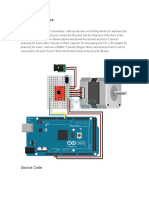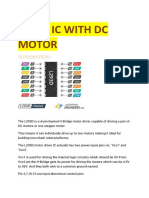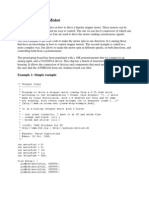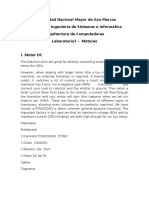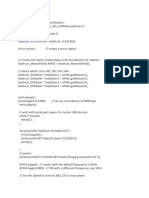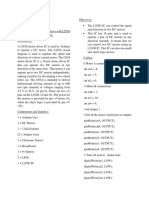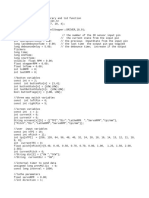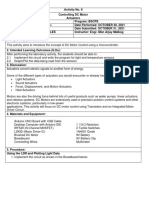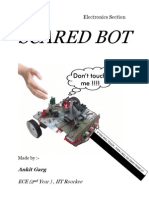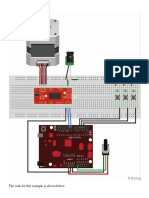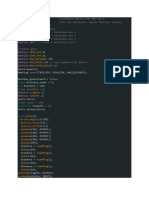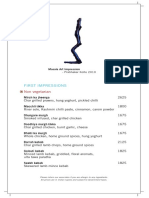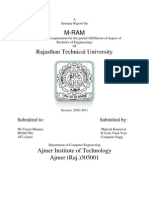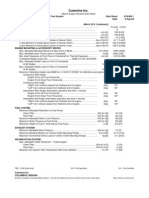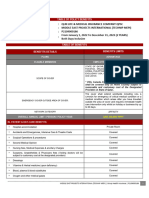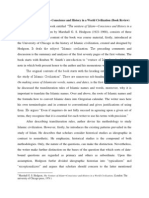Controlling of two DC Motors alternatively with L293D Driver module – Clockwise 3 Sec, Anticlockwise 3
sec and stops for 1 sec.
void setup()
{
pinMode(4, OUTPUT);
pinMode(5, OUTPUT);
pinMode(6, OUTPUT);
pinMode(7, OUTPUT);
}
void loop()
{
//clockwise, Anticlockwise & Stop of M1
digitalWrite(4, HIGH);digitalWrite(5, LOW); delay(3000);
digitalWrite(4, LOW);digitalWrite(5, HIGH); delay(3000);
digitalWrite(4, LOW);digitalWrite(5, LOW); delay(1000);
//clockwise, Anticlockwise & Stop of M2
digitalWrite(7, HIGH);digitalWrite(6, LOW); delay(3000);
digitalWrite(7, LOW);digitalWrite(6, HIGH); delay(3000);
digitalWrite(7, LOW);digitalWrite(6, LOW); delay(1000);
}
A robotic system using a DC motor that detects objects and halts automatically.
#include <NewPing.h>
#define TRIG_PIN 9
#define ECHO_PIN 10
#define MOTOR_A_FWD 5
#define MOTOR_B_FWD 7
NewPing sonar(TRIG_PIN, ECHO_PIN, 200);
void setup() {
pinMode(MOTOR_A_FWD, OUTPUT);
pinMode(MOTOR_B_FWD, OUTPUT);
}
void loop() {
delay(50);
if (sonar.ping_cm() > 15) {
digitalWrite(MOTOR_A_FWD, HIGH);
digitalWrite(MOTOR_B_FWD, HIGH);
} else {
digitalWrite(MOTOR_A_FWD, LOW);
digitalWrite(MOTOR_B_FWD, LOW);
delay(500); // Pause before stopping
}
}
Rotation of a stepper motor in a specific direction and reverse it
#include <Stepper.h>
const int stepsPerRevolution = 2048;
Stepper myStepper(stepsPerRevolution, 8, 10, 9, 11);
void setup() {
myStepper.setSpeed(15);
Serial.begin(9600);
Serial.println("Stepper motor control initialized");
}
void loop() {
Serial.println("Rotating clockwise...");
myStepper.step(stepsPerRevolution);
delay(1000);
Serial.println("Rotating counterclockwise...");
myStepper.step(-stepsPerRevolution);
delay(1000);
Serial.println("Cycle complete, waiting for next rotation...");
delay(2000); // Additional delay between cycles
}
Control Servo Motor from 0 to 180 degrees and reverse with a increment of 1 degree
#include <Servo.h>
Servo myservo;
void setup()
{
myservo.attach(9);
Serial.begin(9600);
}
void loop()
{
int pos;
for (pos = 0; pos <= 180; pos += 1)
{
myservo.write(pos);
Serial.print("The Current Position is ");
Serial.print(pos);
Serial.println(" Degrees");
delay(500);
}
for (pos = 180; pos >= 0; pos -= 1)
{
myservo.write(pos);
Serial.print("The Current Position is ");
Serial.print(pos);
Serial.println(" Degrees");
delay(500);
}
}
Smart Parking Barrier System using a Servo Motor that opens and closes the parking barrier
#include <Servo.h>
Servo barrierServo;
const int trigPin = 9;
const int echoPin = 10;
const int servoPin = 6;
long duration;
int distance;
int thresholdDistance = 30;
void setup() {
pinMode(trigPin, OUTPUT);
pinMode(echoPin, INPUT);
barrierServo.attach(servoPin);
barrierServo.write(90);
Serial.begin(9600);
}
void loop() {
digitalWrite(trigPin, LOW);
delayMicroseconds(2);
digitalWrite(trigPin, HIGH);
delayMicroseconds(10);
digitalWrite(trigPin, LOW);
duration = pulseIn(echoPin, HIGH);
distance = duration * 0.034 / 2;
Serial.print("Distance: ");
Serial.println(distance);
if (distance < thresholdDistance) {
barrierServo.write(0);
delay(5000);
barrierServo.write(90);
}
delay(500);
}
Display the message "FIS" on the first line and "KL University" on the second line of an LCD screen.
#include<LiquidCrystal.h>
LiquidCrystal lcd(12, 11, 5, 4, 3, 2);
void setup()
{
lcd.begin(16, 2);
}
void loop()
{
lcd.setCursor(0,0);
lcd.print("FIS");
lcd.setCursor(2,1);
lcd.print("KL University");
}
Servo Angle control with Potentiometer and display on LCD
#include <Servo.h>
#include <Wire.h>
#include <LiquidCrystal_I2C.h>
Servo myServo;
const int potPin = A0;
const int servoPin = 9;
LiquidCrystal_I2C lcd(0x27, 16, 2);
void setup() {
myServo.attach(servoPin);
lcd.begin();
lcd.backlight();
lcd.print("Servo Position:");
}
void loop() {
int potValue = analogRead(potPin);
int servoAngle = map(potValue, 0, 1023, 0, 180);
myServo.write(servoAngle);
lcd.setCursor(0, 1);
lcd.print("Angle: ");
lcd.print(servoAngle);
lcd.print(" ");
delay(15);
}
Potentiometer-Controlled Differential Drive Robot using DC motors
const int potPin = A0;
const int leftMotorPin1 = 9;
const int leftMotorPin2 = 10;
const int rightMotorPin1 = 11;
const int rightMotorPin2 = 12;
void setup() {
pinMode(leftMotorPin1, OUTPUT);
pinMode(leftMotorPin2, OUTPUT);
pinMode(rightMotorPin1, OUTPUT);
pinMode(rightMotorPin2, OUTPUT);
}
void loop() {
int potValue = analogRead(potPin);
int motorSpeed = map(potValue, 0, 1023, -255, 255);
if (motorSpeed > 0) {
analogWrite(leftMotorPin1, motorSpeed);
analogWrite(rightMotorPin1, motorSpeed);
analogWrite(leftMotorPin2, 0);
analogWrite(rightMotorPin2, 0);
} else {
analogWrite(leftMotorPin1, 0);
analogWrite(rightMotorPin1, 0);
analogWrite(leftMotorPin2, -motorSpeed);
analogWrite(rightMotorPin2, -motorSpeed);
}
delay(100);
}
Movement base controlled Stepper Motor with LCD Display
#include <Stepper.h>
#include <LiquidCrystal_I2C.h>
const int stepsPerRevolution = 200;
Stepper myStepper(stepsPerRevolution, 8, 9, 10, 11);
LiquidCrystal_I2C lcd(0x27, 16, 2);
const int pirPin = 2;
int motionDetected = 0;
void setup() {
pinMode(pirPin, INPUT);
myStepper.setSpeed(60);
lcd.begin();
lcd.backlight();
lcd.print("Waiting for");
lcd.setCursor(0, 1);
lcd.print("motion...");
}
void loop() {
motionDetected = digitalRead(pirPin);
if (motionDetected == HIGH) {
lcd.clear();
lcd.print("Motion Detected");
myStepper.step(stepsPerRevolution);
lcd.clear();
lcd.print("Stepping...");
delay(2000);
lcd.clear();
lcd.print("Waiting for");
lcd.setCursor(0, 1);
lcd.print("motion...");
}
delay(500);
}









